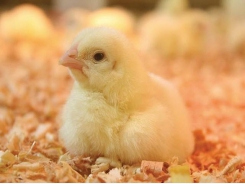Nematodes: not all bad

It may surprise many farmers that not all nematodes (eelworms) are harmful to crops.
Plant-parasitic nematodes can be controlled by beneficial nematodes and other soil organisms in healthy soil. The plant on the right has nematodes, the other is clean.
In fact, many are beneficial. The harmful group are plant-parasitic species and can be either ectoparasites that damage roots from the outside, or endoparasites that enter the roots. The most well-known of these is the root knot group, which makes easy-to-spot lumps on the roots. Most cultivated soil will have fewer than 100 nematodes per teaspoon, whereas untilled good organic soils that are not tilled may have up to 500.
Poor-quality soils with infected crops will have mainly plant parasitic nematodes, while the opposite is true for healthy soil. Compact clay soil will have fewer nematodes than lighter soil and soil with a crumb structure due to high organic content.
There are many thousands of nematode species; most research concentrates on plant parasitic nematodes, not the free-living species. Different species are of different sizes, but most cannot be seen with the naked eye. The exceptions are females of the root knot and cyst types when full of eggs.
Each free-living nematode species has a different function in the soil. Some will consume only bacteria, and as bacteria have a narrow carbon:nitrogen ratio compared with that of nematodes, the excess nitrogen passes through the nematodes and becomes available for plants and other organisms.
Some free-living species play an important role in controlling pathogenic fungi. Others consume protozoa, while still others target other nematodes of both the beneficial free-living and plant-parasitic type. Some attack insects and are used for biological pest control. They enter the host as juveniles and develop and feed in the host.
Mulch
We still have much to learn about no-till farming and the role of surface mulch. However, it would be fairly safe to say that surface mulch not only improves the organic status of the soil, but hosts larger numbers of beneficial nematodes.
Most of the nematodes concentrate in the rhizosphere (close to the roots), as discussed in a previous article, because the plant feeds the bacteria with sugary exudates. The bacteria then proliferate and provide food for free-living nematodes. Early in my career, I was taught to rest the soil by letting it lie fallow. Now researchers are finding that, with continuous cropping, we provide resources for the micro-organism complex, which in turn benefits the soil and crops.
However, while it is a good idea to plant the next crop as soon as possible, the soil should never be worked when wet as this can cause considerable damage. Rather wait till the soil stabilises before planting.
In general, the soil should be disturbed as little as possible when preparing the land for the following crop. Tillage adversely affects the complexity and balance of the soil food web. It also has a greater impact on the fungal-eating and other nematode types than on bacteria consumers.
Working in crop residue will boost the bacteria population and, in turn, the bacteria-consuming nematodes. However, nematodes increase at a far slower rate than bacteria.
Soil food complex
The soil food web complex recycles minerals in the soil. Nitrogen, one of the most important plant nutrients, is largely tied up in the bodies of the organisms in a healthy soil. As it passes through the digestive system of the organisms, it is briefly available for the plant to use before being ingested by bacteria. In this way, the bacteria act as slow-release fertiliser for the crop and drastically reduce the leaching of nitrogen from the soil during heavy rain. Only a small portion of unattached nitrogen can be leached at a time.
The nitrogen content of plant residue also plays a role. If the C:N ratio is higher than 30:1, all available nitrogen will be used by organisms decomposing organic matter and more carbon will be released into the air.
With a lower C:N ratio, more nitrogen is available to the plant during transfer from one organism to the next. We can now see that the advantages of caring for and feeding the soil properly go well beyond the benefits of an improved humus content.
Có thể bạn quan tâm
Phần mềm

Phối trộn thức ăn chăn nuôi

Pha dung dịch thủy canh

Định mức cho tôm ăn

Phối trộn phân bón NPK

Xác định tỷ lệ tôm sống

Chuyển đổi đơn vị phân bón

Xác định công suất sục khí

Chuyển đổi đơn vị tôm

Tính diện tích nhà kính

Tính thể tích ao hồ



 Water can be the hidden problem in poor…
Water can be the hidden problem in poor…  Which markets will benefit from hike in Chinese…
Which markets will benefit from hike in Chinese…